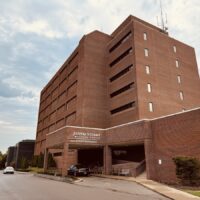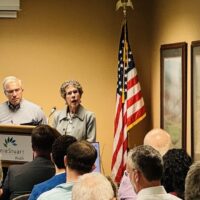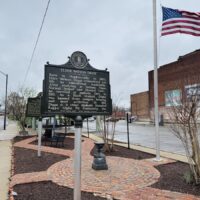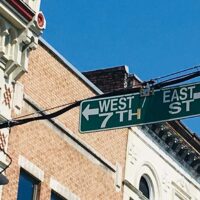I was the last person who was going to contract COVID-19. My close friends thought so because I tried hard to avoid being exposed to the virus.
For four months, I worked from home and wrote stories about other people who got the virus. My hands started to feel like sandpaper because I washed them several times a day in hot, soapy water. I cleaned door knobs and countertops when my husband came and went from work. John did our weekly grocery run, always first thing on Sunday morning before most of the other shoppers arrived.

When I did go out, I wore a mask inside buildings and didn’t linger close to anyone. I wore my mask to pick up curbside orders from our favorite restaurant downtown on Saturday evenings. I wasn’t shy about asking another shopper in Kroger’s check-out line to give me some space. Another time I asked a Walgreens employee to open the register at the photo desk because her co-worker at the main check-out was wearing a mask on her chin. (I see that a lot, and I still don’t understand it.)
None of these things seemed especially difficult to me. The hardest part of the pandemic was spending long stretches of time home alone.
I was motivated to avoid an illness that could put me in the hospital and maybe on a ventilator. I am 58 years old, the same age my mother was when she died on a ventilator. That awful fate didn’t seem like a remote possibility to me.
So in early July, when I couldn’t make sense of fatigue that hit me in waves, I went to the Christian County Health Department’s drive-thru site to be tested. The same nurse who collected the specimen with a nasal swab called me two days later to tell me the test was positive for COVID-19.
The nurse listened to me unravel for a couple of minutes over the phone, and when I asked her how I would know if I was in trouble and needed to go to the hospital, she said, “You’ll know.” Then we got down to identifying the people who might have been exposed to the virus through me. There were about 15 people who got instructions to quarantine, and as far as I know none of them became ill.
My worst symptom was fatigue. One night I texted a friend and described, “It’s terrible but tolerable.” For days I felt like I was in a brain fog. Trying to write a paragraph or read a couple of emails exhausted me. I was more sensitive to the heat and humidity than I had ever been in my life. I was drained, but I ran a fever only one night and I never had the respiratory distress that many COVID-19 patients say feels like trying to get air with an elephant sitting on your chest.
Feeling normal again took longer than I expected. But I am fortunate. Others are hospitalized for weeks. More than 160,000 people in the United States have died from COVID-19 and more than 5 million have been infected. As of Tuesday, Aug. 11, there have been 675 confirmed cases and nine deaths in Christian County.
I’m writing about this now because it’s important to know that the coronavirus can reach almost anyone — including people who try hard to avoid it. Also, it seems odd for me to keep writing news stories about all the ways the pandemic is affecting my hometown without acknowledging that it has also affected me.
The News Is Personal
In community journalism, there are fewer degrees of separation between reporters and the stories they cover than there are in large media markets. Often it feels like there are zero degrees of separation, especially when the news happens to a reporter.
The Christian County Health Department, for example, is Hoptown Chronicle’s main source for a daily coronavirus update, and it is also the agency that provided information I needed about my personal health. The nurse who called to tell me I had COVID-19, and who followed up with daily text messages to check on me during my isolation at home, is not a stranger to me. I’ve known her family since I was in elementary school.
Jennie Stuart Medical Center has also been a resource for reporting stories. And the hospital’s emergency room provided care to me one day in late July, a week after my isolation period had ended.
Doctors are still learning what the virus does in the body after a person is no longer testing positive. There is no simple chart that spells out every symptom or pinpoints exactly when a person can expect to be feeling normal again. In my case, I ended up in the ER with something that felt like a coronavirus hangover even though I had two tests showing I was no longer positive for COVID-19. Coronavirus hangover is not a medical term, of course. It’s just my best way to explain that the virus doesn’t strike everyone the same way and recovery can take a while.
Since the pandemic began, at times I’ve questioned the health department about the agency’s transparency. That is my job.
But I’ve also seen how the health department and the hospital provide coronavirus services to the public that exceed what’s offered in other communities. The drive-thru testing programs in Hopkinsville, first at Jennie Stuart’s Express Lab and now with the health department’s site at Tie Breaker Park, have been a huge asset. While people elsewhere wait in lines half a day or longer for a test, and then wait a week or more for a result, the opposite is true here. The longest I’ve waited in the test line was 45 minutes, and the health department called back with the results in two days each of the three times I was tested. Everyone that I’ve encountered at the health department’s test site has been helpful and efficient. The same was true at Jennie Stuart’s ER.
Even Mild Cases Disrupt Lives
People who think the response to the coronavirus is overblown will often argue that relatively few people die from COVID-19 and most of them are very old.
First of all, it is cruel to discount the lives of older people, as if they are necessary collateral damage while the pandemic runs its course.
And having a mild case of COVID-19 is still a major disruption for both the people who test positive and have to self-isolate and for their direct contacts, who have to quarantine. The health department told me to self-isolate for 10 days, and that was based on when I thought I first had symptoms. I elected to self-isolate a few more days because I wanted to make sure I got a negative test back and didn’t put my husband at any risk. He quarantined for 14 days on the first floor of our house, and I stayed on the second floor. It was a long two weeks.
One of my direct contacts was Kate Russell, who co-owns Hopkinsville Brewing Co. I had interviewed Kate at the brewery the morning of July 10, a few hours before I learned I was positive for COVID-19. We both wore masks and sat outside the brewery at the same table during the interview. But we were within 6 feet of each other for more than 10 to 15 minutes, which is the measure health officials use to determine a direct contact.
I cringe when I think about how this put Kate’s life on hold. She couldn’t work for two weeks, a big deal for a small business owner who was already hustling to offset the pandemic’s economic impact on her livelihood and her family. Fortunately, co-owner Joey Medeiros kept things going at the brewery.
Other friends of mine had their lives disrupted, as well. The health department gave them instructions to quarantine for one to two weeks, depending on how long it had been since they were in close contact with me.
Looking back, I realize I shouldn’t have gone to the brewery to interview Kate while I was waiting for a test result. My symptoms were erratic, and I had convinced myself it couldn’t be the virus. Kate has been gracious about this, to say the least. We texted often during my isolation. She used the quarantine time to work on some projects at home. She now has a hall closet lined in cedar panels, and she’s got a new trailer hitch on the back of her vehicle.
Learning to Fight About What Matters
The pandemic has been exhausting for just about everyone, and I think that’s how I probably became infected. For a few days in mid-June, I let my guard down when my mother-in-law died and we had family coming into town for an outdoor funeral. We shared some meals and there were several people in and out of the house. I took two of my grandchildren to get ice cream. One night, John and I wanted to go out for a beer. Another evening, I went to a friend’s home and visited with several people I had not seen in a few months.
Two weeks later, when I was isolated in my bedroom and hoping I would not develop the worst symptoms of COVID-19, I had a moment when I thought about getting into an argument with local health officials. I’ll blame it, in part, on the brain fog.
The health department had mailed a two-page legal document to my house. I was asked to sign the agreed order that listed several restrictions I was told to observe during isolation. The letter included a note telling me to photograph the signed document and return it by text message to the health department.
One of the restrictions said I would agree to not use an ambulance without the prior approval of the health department. That seemed ridiculous to me. A person who needs an ambulance does not have time to first call the health department and hope that someone will be available to approve that request quickly.
Then I tried to imagine how I could protest one part of a state government form to my local health department, an agency already stretched to the limits in a pandemic. And I decided this wasn’t a fight worth having. I might have been right but it still would have been misguided on my part. If something went terribly wrong and I needed an ambulance, I knew what would probably happen.
So I signed the agreed order and sent it back as requested. The next morning, I came across a news article about a woman named Elizabeth Linscott, who lives near Elizabethtown in Hardin County. Linscott had tested positive for COVID-19, and she noticed the same thing I had about the agreed order when it came from her health department. She wouldn’t sign it, several news outlets reported.
Linscott’s disagreement with health officials became news after the Lincoln Trail Health Department went to Hardin Circuit Court and obtained a judge’s order that forced her to comply. The county sheriff and the health director then delivered the judge’s order to the Linscott home, and a deputy put ankle monitors on Elizabeth Linscott and her husband.
In a follow-up to the initial story, The News Enterprise in Elizabethtown learned from court documents there was more to the dispute. Linscott hadn’t simply disagreed about having to get permission to use an ambulance. She argued there wasn’t even a pandemic and instead proposed her own written agreement with the health department.
“I will do my best to stay home, as I do every other time I get sick. But I cannot comply to having to call the public health department every time that I need to go out and do something,” she wrote, according to The News Enterprise story.
She added, “It’s my right and freedoms to go where I please and not have to answer to anyone for it. There is no pandemic and with a survival rate of 99.9998 percent, I’m fine. I will continue to avoid the elderly, just like prior guidelines state, try to stay home, get rest, get medicine and get better. I decline.”
There’s a time and place to argue with public officials. I’m confident it’s not in the middle of a pandemic while you are stuck in your bedroom hoping the virus doesn’t do lasting harm to you and the people you care about.
I’m glad I didn’t pick that battle. I’d rather fight COVID-19.
(Hoptown Chronicle editor and founder Jennifer P. Brown can be reached at editor@hoptownchronicle.org.)
Jennifer P. Brown is co-founder, publisher and editor of Hoptown Chronicle. You can reach her at editor@hoptownchronicle.org. Brown was a reporter and editor at the Kentucky New Era, where she worked for 30 years. She is a co-chair of the national advisory board to the Institute for Rural Journalism and Community Issues, governing board past president for the Kentucky Historical Society, and co-founder of the Kentucky Open Government Coalition. She serves on the Hopkinsville History Foundation's board.




